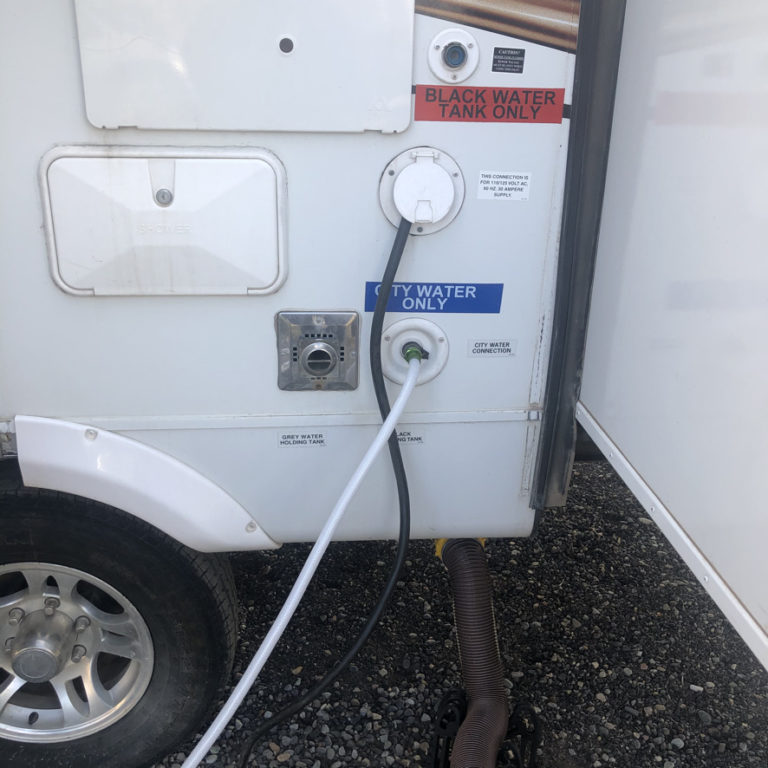Want a Metal Roof for Your RV? Read This Guide!
NOTE*** The content on this page may contain affiliate links, we may make a commission. And, as an Amazon Associate, we earn from qualifying purchases. More information: disclosure page.
If you want to improve the durability and longevity of your RV’s roof, consider replacing it with a metal or aluminum roof.
Aluminum RV roofs are low maintenance so upkeep can be less expensive than alternative materials. They can last longer than other types of RV roofs, like fiberglass. Metal is also more durable, able to withstand piercing tree limbs and preventing holes from friction.

There are several methods of updating your RVs roof to metal, and the installation process is fairly easy. This guide will show you how to install an aluminum roof on your RV and the best ways to maintain it.
For more helpful tips on common RV maintenance issues, check out these blogs:
- How to Replace an RV Door
- RV Electric Setup Basics (RV Plugs and Voltages)
- RV Shower Won’t Drain: 7 Common Causes And Fixes
Common RV Roof Materials
You may assume that since the siding of most RVs is aluminum or fiberglass, your roof is as well. However, there are five different types of RV roofs:
- Fiberglass
- Vinyl
- Aluminum
- Rubber TPO (Thermal Poly Olefin)
- Rubber EPDM (Ethylene Propylene Diene Monomer)
The rubber TPO and EPDM are actually the most common RV roof materials. These synthetic polymers are generally lightweight, cheaper than other roof materials, and easier to repair. They are weatherproof, energy efficient and have a high degree of fire resistance, and contain antimicrobial properties that prevent mold and mildew.
However, that’s not to say other roof types are undesirable. Metal or aluminum roofs are durable, flexible, and easy to maintain. Read on to learn more about why you may want to consider replacing your RV’s roof.
Read more about roofs here: How Long Do RV Roofs Last? (+ 9 Maintenance Tips!)
3 Benefits of Using Metal or Aluminum RV Roofs

Metal RV Roofs are Cost-Effective
Metal can be a cheaper alternative to other RV roofing materials. With proper installation and maintenance, it will require minimal repair work, keeping you and your rig safe for years.
Metal is made to withstand the common collision (think tree branches) and friction caused by high winds that most RVs are susceptible to.
Aluminum RV Roofs Are Lightweight
At around 5 pounds per square foot, aluminum is the lightest and slimmest type of metal roof. Hence, the overall weight of your rig may be lighter than with some alternative roof types.
RV Metal Roofs Are Easy to Install
Lightweight and malleable, aluminum roofs are easier to shape and cut than many other RV roof types.
Some of the most common struggles during installation of RV roofs include cutting holes, edges, and corners to fit the boxes and housing for bends, lids, and covers. With metal roofs, these tasks typically go much faster and more smoothly.
Can I Install a Metal Roof on My RV Myself?

You can install a metal roof on your RV by yourself.
Installing a metal roof on your RV is not as hard as it sounds. With the right equipment and instructions, you should have a properly functioning roof in no time.
*Please seek professional help if you’re uncomfortable doing this yourself or unable to follow the steps safely and correctly.
To replace your RV roof, you’ll need the following tools:
- Hammer
- Nails
- Flashing
- seam tape
- 1″x4″ furring strips
- Pry bar
- Drill
- Self-tapping screws (aluminum)
- Ladder (if your RV does not have one built-in)
- Protective gloves and eyewear
- An electric sander may come in handy to remove old adhesive
Once you’ve gathered all the necessary equipment, follow these steps to begin installing the roof:
How to Install a Metal Roof on Your RV
- First, remove all the items and housing installed on top of your RV such as the roof vents, lids, covers, antennas, and air conditioner/shroud. You’ll want to expose the entire roof membrane.
- Then, carefully begin to remove the old roof using a pry bar to pull up the screws. Start on one corner, working your way down and around then back up the other side of the RV. Clean out any debris.
- While you’re working, pay attention and check for any existing damage such as rotten or broken plywood that may need replaced. Check to make sure the roofing felt and staples are in good condition.
- Replace or repair any areas that need attention with new material.
- Next, you’ll need to clean the entire roof and check for any gaps between joints. If you can see any, you should use a good quality seam tape to close them back up.
- Beginning in the center of the roof, you’ll need to attach your furring strips with 24″ between them on top of the felt. Put a nail every 12″ along the strips.
- Next, flashing will need to be attached along the eaves of the bottom perimeter of the roof. You should be putting a nail about every 6″ along your flashing to ensure it is fastened tight to the roof.
- Throughout this time, you’ll need to be cognizant of where you’ll be needing to reinstall everything that came off of your initial roof (AC units, vents, etc). Mark and cut your metal panels to accommodate these.
- Now it’s time to add the metal roof panels. Your first panel should overhang the eave by about 3/4″. With a drill, insert self-tapping screws through the metal and into the furring strip every 12″ along the length of the strip. Then, insert additional screws every 12″ up the strip.
- Your second panel should be installed by following the same steps as the first, and so on until you have covered the entire roof.
- Double-check for any loose screws or gaps between panels and fix accordingly.
Can You Put a Metal Roof Over a Rubber Roof?
Technically, yes, you can put a metal roof over a rubber roof.
While not necessary for most situations, you could do this to add an extra layer of protection to your RV roof. However, realize that doing this will put quite a bit of extra weight on your rig as rubber is much heavier than aluminum.
5 Helpful Tips for RV Roof Maintenance

Water damage is one of the main problems that can severely affect the roof of your RV, as well as the rest of your home on wheels. A leaky roof can lead to rotten wood frames or paneling, moldy interiors, broken electrical fixtures, and more. The costs of repair can be very extensive.
To prevent water damage to your RV, here are some tips to remember for optimal maintenance of your RV’s metal or aluminum roof:
- Inspect when the weather is nice. Beat the rain, cold temperatures and snow accumulation to ensure a thorough inspection of the siding, eaves, and roof of your RV. Look for gaps between metal panels and roof fixtures, missing screws, holes, or any other areas where moisture can accumulate and leak under the roof.
- If you see any damage on your RV roof, make sure to quickly repair it using the right waterproof sealants, new screws, or other necessary supplies.
- When choosing the right sealant for your rig, make sure to use one that is specifically made for an RV roof and the one that can keep it cool.
- If a seal is damaged beyond repair, you can apply seam tape over it. A good quality seam tape can keep the joint on your RV roof intact for a long period until you’re able to properly fix or replace that area.
- Always check the front and the rear caps of your roof to make sure that there are no seams or gaps between panels.
For answers to some other RV roof-related questions you may have, see these posts:
Metal RV Roof FAQs
Will a Metal RV Roof Be Loud When It Rains?
Rain falling on a metal or aluminum roof will be louder than a rubber roof. However, to minimize the noise you can opt to layer rubber over your aluminum roof or lay a different type of insulation over it. You can also add two coats of white Elastomeric coating, which will not only dampen the sound of rain on the roof but also reflects the heat of the sun, keeping the interior of your rig cooler during the day.
How Often Does an Aluminum RV Roof Need Replaced?
Metal or aluminum RV roofs don’t need to be replaced often. With proper routine maintenance, they can last up to 10 years or even longer. Inspect your RV roof regularly, looking for any gaps or punctures. Repair any damaged areas as soon as possible.
Does Flex Seal Work on RV Roofs?
You can use rubberized liquid sealants such as Flex Seal and NovaFlex Metal Roof Sealant on metal RV roofs. These waterproof adhesives come in a variety of products such as glues, caulks, sprays and tapes and are designed to help prevent leaks. However, these should be used on small damaged areas and may not be sufficient for permanent fixes.
How Much Does It Cost to Reseal an RV Roof?
Resealing a metal roof can cost about 21 cents per square foot. If you’re only dealing with a small leak, you may be able to increase the lifespan of your RV’s roof by fixing it immediately using a good quality sealant. Most RV manufacturers use an elastomeric roof coating, such as Dicor, to seal their roofs. You can find these online – or in most stores that carry RV supplies – for about $50 USD for a gallon.
Does RV Insurance Cover Roof Leaks?
Anything related to maintenance (or lack thereof) is not covered by your RV insurance. Hence, roof leaks will not be covered. However, if your RV roof gets damaged from a collision, a tree branch falling on it, or is damaged by a storm, it will be covered by your insurance.

How Much Weight Does an RV Roof Support When Walked On?
Proper RV roof maintenance and repairs will require walking on it. Additionally, you may want to store something for your trip – like kayaks or bicycles – on the RV’s roof.
Generally, an RV roof can easily support an average of 220 to 300 pounds. Your RV’s ladder and owner’s manual both should include the roof’s weight limit, or you can contact the manufacturer if you’re still unsure.
Want a Metal Roof for Your RV?
In conclusion, metal or aluminum RV roofs are generally budget-friendly, lightweight, and easy to install and maintain. These durable options provide many benefits that you can enjoy over many RV adventures.
Whether upgrading your RV roof or planning your next destination vacation, it helps to keep track of all of your expenses. Take a look at our Etsy Store to download some useful printable planners. These simple tools will keep you up-to-date on your spending and help you stay within your budget.

If you want other options for your RV roof, check my other post about rubber ones.

Hi, I’m Shauna – Welcome to Family Travel Fever. We are a large family, that was bitten by the travel bug! I take the kids by myself because I don’t mind flying or driving solo with my crew to discover the coolest places.
Sign up for our email list for my best travel tips plus get the family travel planner free.






Metal roof are definitely low maintenance but when you do get a link our shop only uses http://www.rvroofmagic.com for our rv roof repair. we and the dicor caulk both have histories in the rv community and the rvroofmagic significantly cools down the rv